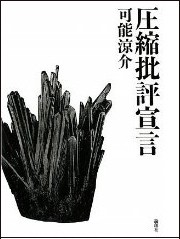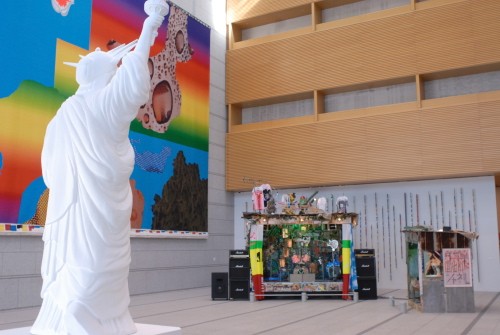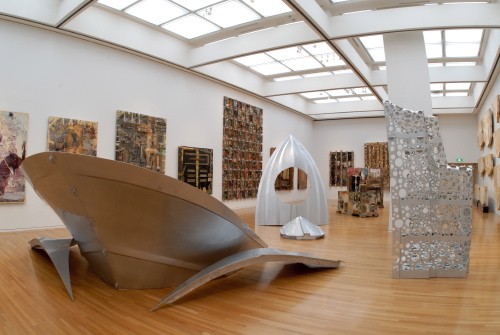Where is the contemporary in Ohtake Shinro?
As from this month I’ll be contributing a column monthly. I’ve just now sat at my desk to pen the first of these. I’m already writing monthly exhibition reviews for Bijutsu techo, so here I’d like to try exploring a slightly different format. I’ll probably end up writing about several exhibitions or events rather than restricting myself to a single show. But what if I incorporate miscellaneous happenings that crop up as I go about my daily routine and write frankly about these and their impact on the rhythm of my life? For a start, this is the realm not of front-lit text printed on opaque paper, but of back-lit web content viewed on a light-emitting screen. Even though it’s not a diary, at times it will probably be read like one. And of course be written like one.
Criticism of Ohtake from outside the art world
For example, the fall semester has just begun, and I currently have on the desk in front of me a copy of a new publication I found in my mailbox when I dropped into my university study after a long absence. As a preliminary step, perhaps we can use this to consider the state of the art world recently. The new publication in question is Kano Ryosuke’s Asshuku hihyo sengen (Ronso-sha). This is a book of so-called ‘literary criticism’ built around a selection of monthly surveys of the literary scene, book reviews, and other articles written by the author over the last few years, but there is a specific reason why I’ve decided to focus on it here. In the discussion(1) included at the end of the book, mention is made of an essay on Ohtake Shinro I previously wrote for the magazine Shincho (“Samusa to zankokusa kara naru hibiki no buruzu” (Reverberating blues full of coldness and cruelty), Nannimonai tokoro kara geijutsu ga hajimaru (Art starts from nothing) (Shinchosha), and so I felt I needed to respond to what was said.
 Kano Ryosuke Asshuku hihyo sengen (Ronso-sha)
Kano Ryosuke Asshuku hihyo sengen (Ronso-sha)Ohtake Shinro was, of course, the subject of a major retrospective several years ago at the Museum of Contemporary Art Tokyo, an exhibition that suddenly boosted his recognition among the public at large. It’s safe to say that this was a major turning point for the artist. However, if we ask ourselves whether this led to adequate discussion taking place around such questions as the role of this exhibition or the positioning of artists within the all-important art world, then the answer would have to be no. In fact, at the same Museum of Contemporary Art Tokyo alone, before Ohtake’s exhibition there was a number of solo shows by artists who stood out (within the art world) from the 1980s onwards, such as Morimura Yasumasa and Murakami Takashi, Yokoo Tadanori and Mori Mariko. Yet, one could hardly say that any of these has been the target of a critical summarization within the art world. Naturally, even without such a summarization, these artists eventually embark on their ‘subsequent’ careers. But isn’t this turning the ‘thereafter’ of artists in Japan into something rather ambiguous? The same could probably be said of Ohtake. I definitely felt this was the case, which is why I was grateful that this exhibition was addressed head on in the discussion mentioned above far removed in critical terms from its original context (and from the art world), and why I, too, feel the urge to become involved in this discussion, albeit well after the fact.
 Installation view of Ohtake Shinro Zen-kei Retrospective 1955-2006 (Museum Contemporary Art Tokyo, 2006)
Installation view of Ohtake Shinro Zen-kei Retrospective 1955-2006 (Museum Contemporary Art Tokyo, 2006)Photo Hirano Kuniko, Courtesy Museum Contemporary Art Tokyo
Well, in writing the Ohtake essay that came up in this discussion, I used ‘nostalgia’ as a key word. Kano, the author of Asshuku hihyo sengen, responding to Sakaguchi Ango’s concept of ‘nostalgia’ upon which mine was modeled, tries to view Ohtake’s ‘trash’ in the context of the ‘pebbles’ of the present era, in which everything is equal and nothing sticks out. However, at the same time he also says that Ohtake’s trash exhibits a (cultural anthropological) precariousness in which the sacred and the profane come and go and in which excrement turns into gold. This apparent vagueness is seized on by Otori and Suga, who go as far as suggesting Kano is being romantic.
Pebbles are certainly nostalgic. As a child, almost every one of us would have picked up a pebble on the roadside and thrown it far into the distance for no particular reason. This yearning for distance and the unmistakable feeling of ‘presence’ derived from holding a pebble, neither too heavy nor too light, in one’s hand take root deep inside the body and remain, returning unexpectedly even after we become adults in the form of a strange sensation in the palm of the hand (something you realize when you actually pick up a pebble). Because this is what we mean by nostalgic, here nostalgia relates not so much to memory but to the sense of touch. And so although I wouldn’t go as far as saying this means it shuns romanticism, I would say that at the very least Ohtake’s trash, while it could be described as nostalgic, doesn’t consist of memory traces (in this regard Ohtake and Yokoo Tadanori are poles apart), and even when viewed directly appears to lack actual reproducibility, consisting instead of a random collection of tactual recollections (of when the objects concerned were collected). In other words, rather than being something from which ‘scenes to which one wishes to return’ (Sunouchi Toru) immediately manifest themselves, Ohtake’s trash seems to reveal little substance at all on being simply viewed regardless of how carefully one scrutinizes it. It’s only when we’re reminded of various sensations, such as ‘picking up’, ‘having picked up’, or ‘I’ve picked that up myself’ yet ‘I don’t know what it is’ that these works begin to take on Ohtake-esque qualities.
Conversely, this is also the reason why Ohtake’s works lack history. In the discussion referred to above, Suga expresses annoyance that Ohtake’s trash doesn’t yield meaning as ‘wreckage of the past etched in history’ in the same way as Tadeusz Kantor’s plays or Ilya Kabakov’s installations, which also have junk-like qualities, although if Ohtake’s trash were the ‘pebbles’ that Kano says it has the possibility of being, then it’s only natural that history is excluded from the outset. Rather, it’s because such gravity has no chance of intruding that this trash is able to maintain a practical distance from historicism. It’s this distance=lightness that prompts one to pick up what Suga describes as Ohtake’s ‘reproducible pieces that could easily be mistaken for work by Anselm Keifer, for example’ not as ‘reproducibles’ but as pieces of finished trash, and it’s this that removes from Ohtake’s works the stench of blood associated with Western art and as a result imbues them with a peculiar feeling of cleanliness (but does not cleanse them) despite the fact that they’re trash. It’s because this feeling of cleanliness samples everything equally that we cannot after all call it excrementitious, and in place of the kind of dynamism usually sought in Western art it is tossed brusquely at the viewer. Information may be summarized but it doesn’t speak of its own accord. This is why, even though Ohtake’s work may be described as ‘nostalgic’, it’s confined to a state prior to becoming a narrative, remaining ‘nostalgic’ only in the sense that a lingering note (like a blue note in jazz) is nostalgic, or in other words in a state of tension. It’s completely different from Western art that speaks volubly of its meaning regardless of whether it has been invited to do so, and perhaps this is the reason why it ought to be called not a fragment of history but pebbles on the roadside.
 Installation view of Ohtake Shinro Zen-kei Retrospective 1955-2006 (Museum Contemporary Art Tokyo, 2006)
Installation view of Ohtake Shinro Zen-kei Retrospective 1955-2006 (Museum Contemporary Art Tokyo, 2006)Photo Hirano Kuniko, Courtesy Museum Contemporary Art Tokyo
Neither poor nor rich
Incidentally, I’m unable to take much of an interest in either Kantor or Kabakov, and for the same reasons I’ve just outlined. Even though their trash may appear poor at first sight, in terms of meaning it is just too rich. And while Keifer’s strength lay in his ability to give an outward show of historicism while stopping just short of this with a hefty dose of kitsch, since the end of the Cold War he has if anything lost his sense of irony by distancing himself from Third Reich imagery, and in recent years is approaching plain symbolism. Consequently, although it could be called melancholic, his work tends to lack tension and appears to descend into the melodramatic. Speaking of melodrama, I had the opportunity to visit Kabakov’s Moscow studio immediately prior to the collapse of the Soviet Union, and although I couldn’t meet the artist as he was visiting the U.S., I still have a very clear memory of what was more an apartment in which he lived than a studio, which was piled with trash and resembled closely (or rather completely) one of his installations. In fact, I felt nothing upon seeing the collection of junk abandoned there and covered in dust. Perhaps this was because, as opposed to the tactual ‘nostalgia’ of Ohtake’s completely dried out trash, Kabakov’s had an air of ‘sadness’ like a stain soaked with blood or tears.
As it happens, at the end of September I’m planning to go and see the Naoshima Bath, Ohtake’s most ambitious artwork (?) since the retrospective at the Museum of Contemporary Art. While soaking in the hot water, I also intend to ascertain whether there’s been any degeneration with respect to the ‘nostalgia’ of Ohtake’s work, whether it still looks like ‘trash’, or whether the process of ‘pebblefication’ described by Kano has intensified.
